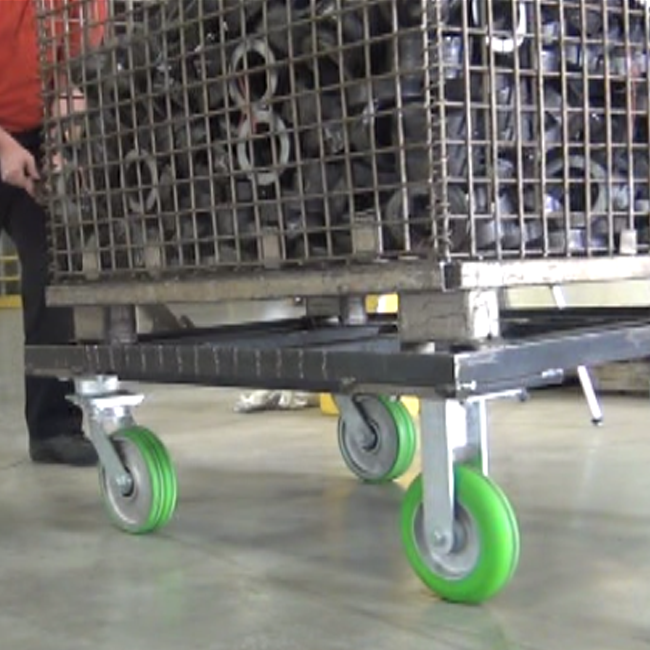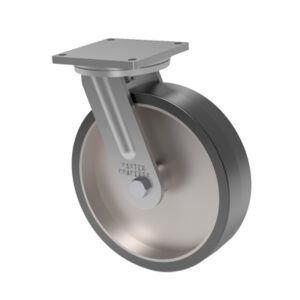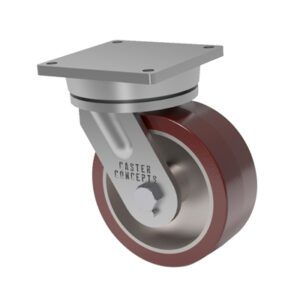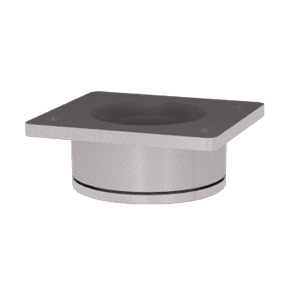

When choosing the right caster for moving heavy production components or finished goods, factors such as cart speed, caster life, and desired maintenance frequency impact the best kingpin design. Heavy-duty industrial casters utilize two main designs for the swivel section of the caster: Kingpin and Kingpinless. Both designs have advantages and disadvantages; which works best for you depends on your application.

90 Series Kingpin Caster
The kingpin swivel section is one of the oldest methods for creating a caster swivel section. It utilizes a stem (sometimes a rivet or bolt) on the top plate to fasten together the lower part of the swivel section.
The kingpin design utilizes a load bearing and a thrust bearing to transmit the load. A threaded kingpin and a slotted nut design are the most standard configurations in heavy-duty industrial swivel casters and are what we reference in this blog. Is a kingpin design right for your application? Let’s take a look at the pros and cons of this design:
Kingpin Advantages: The threaded kingpin allows you to tighten the kingpin for varying levels of swivel resistance.
In certain situations, such as a heavy load situated on an incline, your caster shouldn’t swivel easily. A kingpin caster lets you tighten the nut to a more considerable torque value to decrease the swivel ability. The threaded kingpin-nut design also allows you to adjust the kingpin nut as the swivel section wears, which can prolong the caster’s life. This also gives the user easier access to clean the swivel section if needed.
Kingpin Disadvantages: Due to most of the thrust loads being transmitted through the kingpin, it often becomes a failure point for the caster.
For this reason, kingpin casters are usually not recommended for high-speed towing applications. The high loads associated with turning at high speeds can significantly reduce the capacity of a kingpin-style swivel section.
If a kingpin is improperly designed, it can shear off under load, causing complete caster failure. The proper kingpin caster is critical when developing an application using kingpin swivel casters.

91 Series Kingpinless Caster
The kingpin’s design caster swivel section has only three components: a top plate with a ball race, a yoke base (bottom race) with a ball race, and ball bearings. This design is similar to what one would find in a ball bearing. This design eliminates the kingpin and utilizes the swivel bearings to spread the load over a larger area.
By eliminating the risk of kingpin failure, these casters can contribute to reduced maintenance costs and downtime, resulting in a higher return on investment (ROI) for your material handling operations.
Kingpinless Advantages: Since this design distributes the load over a larger area, it can be used in higher-speed caster applications.
The kingpin’s swivel section also swivels more efficiently and requires less maintenance since no nut needs to be retightened.
Kingpinless Disadvantages: This swivel section design makes adjusting the swivelability of the caster difficult once the caster has been assembled.
This is because the entire swivel section must be removed for a ”swivel restrictor” device to be inserted into the raceway. Also, once the caster swivel section raceways have worn, there is no way to adjust the swivel section to retighten.

sealed swivel section caster
Both kingpin and kingpinless caster swivel section designs have been around for decades, and both have advantages and disadvantages. To properly choose which swivel section is best for the application, it is important to know loading conditions, speed, duty cycle, jobs/hour, floor conditions, and other environmental concerns.
When unsure what swivel section will serve your needs, contact the engineering staff at Caster Concepts to assist with your decision-making process. Caster Concepts engineers have extensive experience designing the caster that best fits your needs and applications. Proper design of the swivel section to meet your needs will provide you with a caster application that will last a long time.